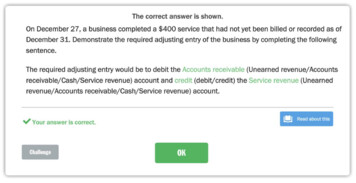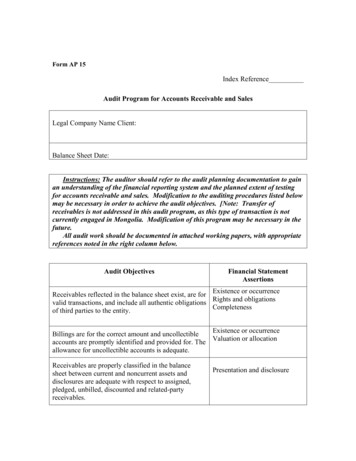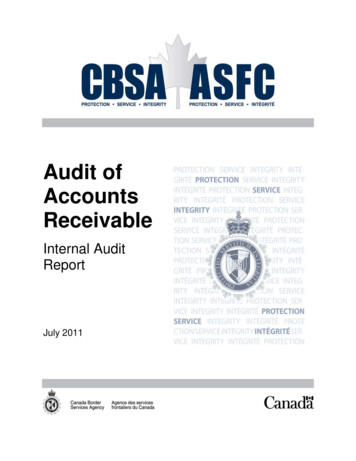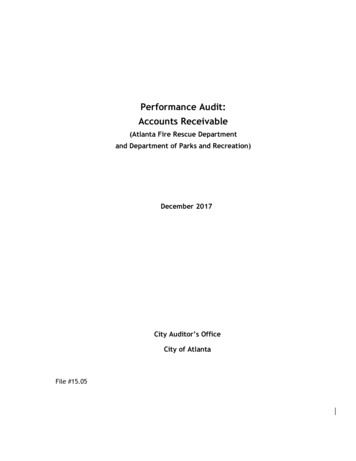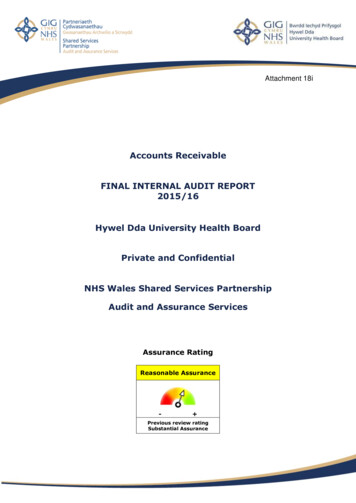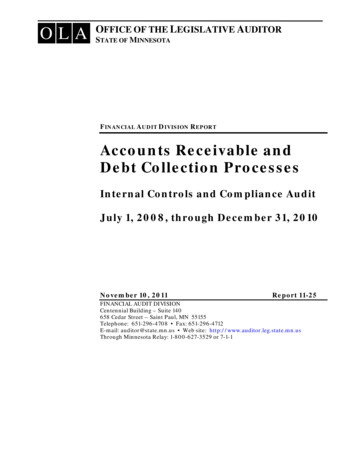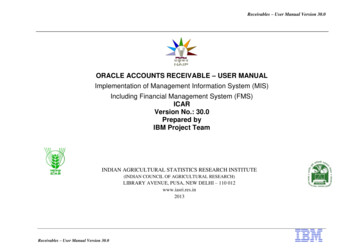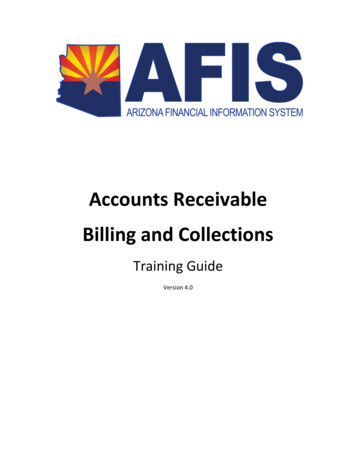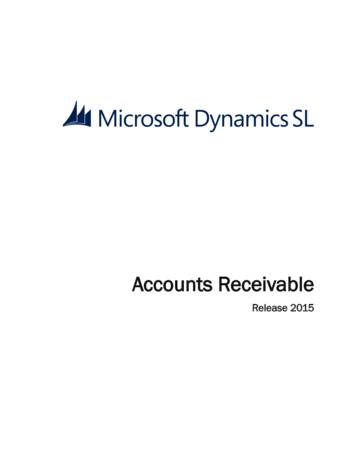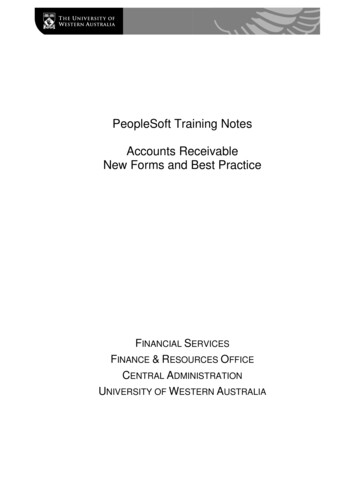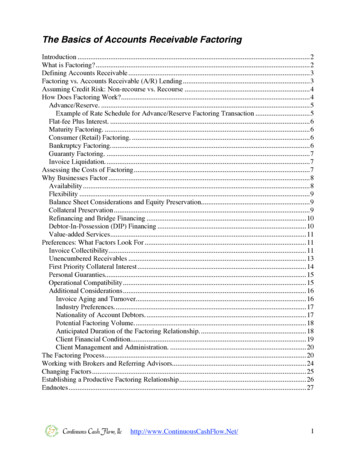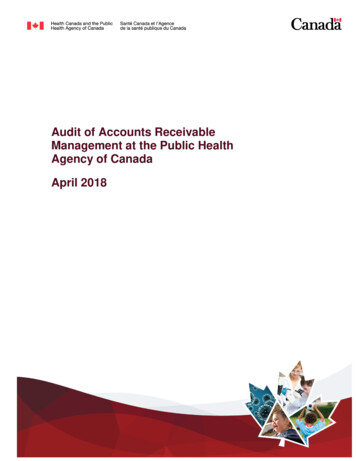
Transcription
Audit of Accounts ReceivableManagement at the Public HealthAgency of CanadaApril 2018
Audit of Accounts Receivable Management at TMarch 2018Audit of Accounts Receivable Management at the Public Health Agency of CanadaApril 2018Table of ContentsEXECUTIVE SUMMARY .A- INTRODUCTION.Background .B- FINDINGS, RECOMMENDATIONS AND MANAGEMENT RESPONSES.Governance .Governance Structure and Oversight .Guidance and Tools .Risk Management .Internal Controls .Recording .Collections.Write-off and Remission .C- CONCLUSION .APPENDIX A – SCORECARD .APPENDIX B – ABOUT THE AUDIT .
Audit of Accounts Receivable Management at TMarch 2018Audit of Accounts Receivable Management at the Public Health Agency of CanadaList of PHACOCFO-PHACPCAPHITSTBTBSTPPAllowance for doubtful accountsAccounts ReceivableChief Financial OfficerCentre for Grants and Contributions, Office of the Chief Financial OfficerDebt Write-off Review CommitteeFinancial Operations Directorate, Shared Services PartnershipGrants and ContributionsGrants and Contribution Information Management SystemHealth CanadaHealth Canada/Public Health Agency of CanadaOffice of Chief Financial Officer, Public Health Agency of CanadaPrivate-sector collection agencyPublic Health Information Tracking SystemTreasury BoardTreasury Board SecretariatTravelling Public ProgramApril 2018
Executive SummaryWhat we examinedWe examined the management control framework that was put in place to ensure fair, effectiveand efficient management of accounts receivable (AR), and minimize the risk of loss.The audit focused on the policies, processes, and procedures in place for recording, collecting,writing off and monitoring AR from external parties during the 2016-17 and 2017-18 fiscal years.Why it is importantReceivables are important government assets that require prudent management. This is integralto achieving the objectives of responsible fiscal management. The Financial OperationsDirctorate, under the Shared Services Partnership, provides services to support themanagement of accounts receivable for the Public Health Agency of Canada.The Treasury Board Secretariat’s Management Accountability Framework for fiscal year 201516 highlighted the importance of, and its expectations for, AR management by including it as anindicator of sound financial management. In addition, the updated Treasury Board Policy onFinancial Management and the Directive on Public Money and Receivables requires DeputyHeads to ensure: Governance and oversight over financial management are effective;Internal controls over financial management are effective;Financial information supports decision-making and accountability to Canadians;Standardized and efficient financial management practices are in place; andThe financial management workforce is agile and sustainable.What we foundWe found that a management control framework was in place to support ongoing managementof AR. We observed that: Policies established for the management of receivables and removal of debt wereconsistent with Treasury Board policies;Internal Control Division monitoring of effectiveness on controls related to ARmanagement provided information to support management of risks related to ARmanagement;Recording of receivables from the cost recovery program was done on a timely basis;and,A process for write-offs is in place and is consistent with the requirements of the DebtWrite-off Regulations.Office of Audit and EvaluationHealth Canada and Public Health Agency of Canada1
Management has made efforts to improve the management of accounts receivable. However,opportunities to address deficiencies were identified in the areas of: Regular reporting to senior management on collection activities or the collectability ofaccounts;Clarifying roles and responsibilities of the various players involved in the accountsreceivable management process;Enhancing guidance and tools to support the collection of outstanding accountsreceivable;Timely recording of receivables from G&Cs recipient audits, and proper documentationof justification of change in receivables;Timely collection action and monitoring of accounts; andEnhancing the process for determining the allowance of doubtful accounts.Management agrees with the recommendations in this report, and has provided an action planto address the agreed upon recommendations to further strengthen the management controlframework supporting accounts receivable management.Office of Audit and EvaluationHealth Canada and Public Health Agency of Canada2
A- IntroductionBackground1. Receivables are defined in the Treasury Board (TB) Directive on Public Money andReceivables as “financial claims incurred through the tax system or arising from accruedrevenues transactions, expenses overpayments and other recoverable payments that willresult in a future inflow of cash 1.” They are core assets that involve millions of dollarsannually and have a wide range of transactions. Given this complexity, departments andagencies are expected to manage resources effectively to ensure sound and prudent use ofpublic funds. The Treasury Board Secretariat’s (TBS) Management AccountabilityFramework (MAF) for fiscal year 2015-16 highlighted the importance of, and its expectationsfor, accounts receivable (AR) management, by including it as an indicator of sound financialmanagement.2. In addition, the TB Policy on Financial Management and the Directive on Public Money andReceivables expect Deputy Heads to ensure 2: Governance and oversight over financial management are effective;Internal controls over financial management are effective;Financial information supports decision-making and accountability to Canadians;Standardized and efficient financial management practices are in place; andThe financial management workforce is agile and sustainable.3. In working to fulfil its mandate, the Public Health Agency of Canada (PHAC) is engaged inactivities that may result in the establishment of an AR. These activities are primarily relatedto the recovery of overpayments from contribution agreements, revenues from inspectionfees, charges to other government departments, and other recoveries, such as those relatedto salary overpayments.4. PHAC’s gross AR balance at the end of fiscal year 2016-17 was 11.6M. As shown inTable 1, this amount is made up of receivables from external parties, other governmentdepartments and agencies, and employee advances. Receivables from other governmentdepartments account for the majority of the AR for PHAC. These receivables relate to theprovision of various finance and administrative services to other organizations within theGovernment of Canada. A significant amount of receivables were classified as employeeadvances. This was mainly due to the challenges resulting from the new pay system. Theintroduction in 2016 of the Pay Transformation Initiative and the new pay system (Phoenix)has resulted in pay challenges, including issues of over-payments and under-payments ofemployees salaries across all government departments and agencies. Receivables fromexternal parties were mainly comprised of recoveries of overpayments from contributionagreements ( 1.2M – 75%) and revenues ( 317K - 19%). The audit focused solely on12Appendix A: Definitions of the TB Directive on Public Money and ReceivablesSection 4 of the TB Policy on Financial ManagementOffice of Audit and EvaluationHealth Canada and Public Health Agency of Canada3
accounts receivables from external parties. Receivables from other governmentdepartments and agencies were excluded due to the low level of risk associated with thecollection of inter-departmental transactions.Table 1 – Breakdown of the Public Health Agency of Canada’s Gross AccountsReceivable as at March 31, 2017External PartiesOther Government DepartmentsEmployee AdvancesTotalAmount( ’000) 1,632 6,197 3,821 11,650Percentage(%)14%53%33%100%5. The Health Canada (HC) and PHAC Standard on the Management of Receivables wasdeveloped by the Financial Operations Directorate, under the Shared Services Partnership(FOD-SSP). The Standard defined the responsibilities and requirements for themanagement of AR within PHAC. Responsibility for the management of accountsreceivable is shared between FOD-SSP, the Centre for Grants and Contributions (CGC),and the Travelling Public Program (TPP) within the Health Security Infrastructure Branch.In general, this process involves activities related to recording or invoicing, collection, andwrite-off. The monitoring of AR occurs within each of these steps.6. The FOD-SSP has responsibility for the collection and monitoring of most accountsreceivable. Recoveries of overpayments on contribution agreements are managed throughthe Centre for Grants and Contributions within the Office of the Chief Financial Officer(CGC-OCFO).Office of Audit and EvaluationHealth Canada and Public Health Agency of Canada4
B- Findings, Recommendations and Management ResponsesGovernanceGovernance Structure and Oversight7. We expected that a governance structure was in place to monitor all activities of the ARlifecycle, from recording to collection, and to eventual write-off of outstanding debts.8. Oversight is important for ensuring effective financial management processes are in place,and it supports the stewardship responsibilities of senior management. This requires anappropriate structure and regular reporting on all phases of the AR lifecycle.9. At PHAC, we found that the Debt Write-Off and Review Committee (DWORC) had been inplace to provide oversight for the removal of debt. However, we found limited documentedevidence to demonstrate oversight of the collection of outstanding non-G&C debts. TheDWORC reported to the Chief Financial Officer (CFO), and met twice a year to review debtwrite-off requests, waivers of interest, and administrative charges requests, and maderecommendations to the CFO.10. While its primary responsibility was for formally revieweing debt write-off requests, theDWORC also received other information relating to receivables and write-offs by region, andaged receivables by program and region. We did not find regular reporting to either theDWORC or to senior management on collection activities or the collectability of accounts.We observed that the write-off of uncollectible accounts at PHAC had increased significantlyfrom 4,236 in FY2014-15 to over 442K in FY2016-17, and at the time of the audit, nearly20 percent of outstanding items were over three years old, which exceeded the time limit forlegal action imposed in most provinces.11. Enhanced reporting on AR management would provide better information to supportdecision-making, and would further enhance oversight within the governance framework.Recommendation 1The Chief Financial Officer (CFO) enhances reporting on accounts receivable to help in themanagement of risks for the collection and collectability of outstanding accounts receivable.Management responseManagement agrees with recommendation.Office of Audit and EvaluationHealth Canada and Public Health Agency of Canada5
The Financial Operations Directorate (FOD) will implement regular reporting to the CFO andDeputy Chief Financial Officers (DCFO) showing the status of outstanding accounts receivableby type and by age.Guidance and Tools12. We expected that internal policies and guidance tools were available to employees todischarge their responsibilities, as they relate to receivables.13. Through the FOD-SSP, multiple governing documents were developed to provide directionrelating to the management of receivables. We examined these documents and determinedthat relevant roles and responsibilities, denoted in the Health Canada/Public Health Agencyof Canada (HC/PHAC) Standard on Management of Receivables and the Standard onRemoval of Debt, were consistent with Treasury Board expectations, and were available toemployees via the intranet.14. We identified opportunities for improvement in regard to the Standards. First, the HC/PHACStandard on Management of Receivables included requirements for the following: an assessment of the creditworthiness of customers, where necessary;use of collection activities that were appropriate and cost-effective, including the use ofprivate-sector collection agencies (PCA) or provincial small claims court; andsuspension of debtor accounts when it appeared debt recovery was unlikely to occur in atimely manner.However, program and accounting o
and efficient management of accounts receivable (AR), and minimize the risk of loss. The audit focused on the policies, processes, and procedures in place for recording, collecting, writing off and monitoring AR from external parties during the 2016-17 and 2017-18 fiscal years.
